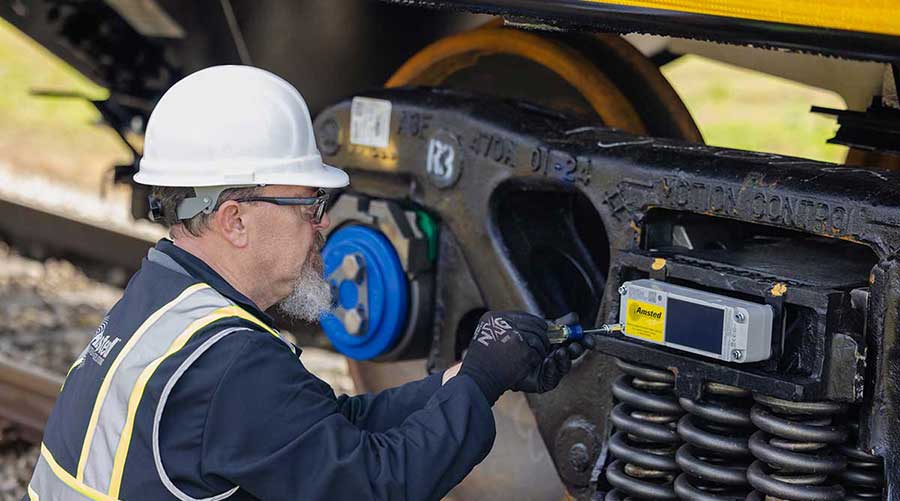Stay updated on news, articles and information for the rail industry
January 2014
Rail News: Rail Industry Trends
Marcellus, Utica shale regions keep railroads busy
— by Julie Sneider, associate editor
Carload Express Inc.'s efforts over the past year to restore a 12.2-mile rail line between Hannibal and Powhatan Point in southeast Ohio underscores the promise that Northeastern natural gas drilling operations in the Marcellus and Utica shales hold for the railroad industry.
Originally built by the Pennsylvania Railroad to service an aluminum plant in Hannibal, the former Ormet Railway line is now operated by the Ohio Terminal Railway Co., a wholly owned Carload Express subsidiary. The restored route, which marked the return of freight-rail service to Monroe County, Ohio, connects local manufacturing and shale production companies with Norfolk Southern Railway and its North American network. In December 2012, Carload Express reached an agreement with Hannibal Real Estate L.L.C. to operate the line, which the real estate firm acquired in 2007.
The line was dormant from 2000 until April 2013, when it was reopened for business following $3 million in upgrades. In June 2013, the Ohio Terminal began transporting its first loads of frac sand for use in the wet-gas portions of the Marcellus and Utica shale regions, says Michael Filoni, vice president of sales and marketing for Carload Express.
"We're seeing steady and growing business for fracturing sand moving into that market," he says. "We really believe that will be a very strong property for us in 2014 and beyond."
The new Ohio Terminal Railway strengthens the short line's ability to serve energy companies in both the Marcellus and Utica shales. Two other Carload Express railroads — the Allegheny Valley and Southwest Pennsylvania — have been busy serving the Marcellus in the wet-gas region of southwestern Pennsylvania. But until the short line launched the Ohio Terminal, Carload Express lacked a "strong foothold" to serve drillers interested in wet natural gas, such as ethane and a light crude referred to as "condensate" in the Utica.
"The Ohio Terminal gives us the best of both worlds," says Filoni. "The Utica is really still in the ramping-up process. But I believe it is going to be a very strong, continuing opportunity. And in the Marcellus, we're seeing more focus by the drillers on the wet-gas areas that we serve. So, I believe we'll continue to see more growth and continued opportunity in those shale plays."
Marcellus Activity Gains
Although activity dipped in the dry-gas regions of the Marcellus in 2012 due to lower natural gas prices, traffic picked back up again in 2013, especially in wet-gas areas. Railroads that operate in the Marcellus and Utica territories have remained busy transporting frac sand, pipe, chemicals and other commodities needed for energy companies' shale activity over the past year, railroad industry representatives say.
Carload Express, which also interchanges with CSX Transportation, is an example of what American Short Line and Regional Railroad Association President Richard Timmons says is a small railroad being in the right place at the right time. The energy companies' Northeast shale activity "has had a very, very positive" impact on short lines over the past three years — in some cases, reviving lines that had been inactive for some time, he says.
"There are a number of railroads, primarily in Pennsylvania, that have benefitted dramatically from the hydraulic aspects of getting at the deposits of gas and oil," says Timmons. "There has been plenty of activity in small railroads supplying frac sand and other materials important to the drilling operations there."
Even more notable in 2013 was the ramp up of activity in the Utica Shale, particularly in western Pennsylvania and in Ohio. As of Dec. 7, 2013, the Ohio Department of Natural Resources has issued 1,015 drilling permits for Utica horizontal wells since 2009. Of those permits, 550 were issued in 2013. The agency issued 376 permits in 2012.
"We have started to see the shift into the western part of Pennsylvania and into Ohio, as the Utica play starts to firm up," says Jim Schaaf, NS' group vice president of metals and construction.
NS' Northeast shale-related volumes were up 5 percent to 10 percent in 2013 over 2012, NS officials say. And, based on what they're hearing from the energy industry, they expect to see traffic growth in the region in 2014.
"We will continue to see further development in the Utica, and we continue to see growth in a very established network and group of customers in the Marcellus," says Schaaf.
Outbound Opportunity
Heavy in natural gas liquids (NGLs), the Utica likely will provide railroads more outbound traffic opportunities than what has been coming out of the Marcellus area, rail execs say. At CSX, for instance, outbound traffic picked up after two NGL fractionation plants opened in West Virginia. The plants are among several major natural gas processing facilities that have opened or are under construction in the region.
"I think there is a lot of potential in the Utica," says Rich Karn, director of marketing, chemicals and fertilizer at CSX. "It's relatively underdeveloped compared to the other major shales in the country, especially when compared to the Marcellus, which it's next to. What we're talking about is inbound sand and outbound NGLs. There also is the potential for condensate, and that really is in its infancy in being developed. And rail will be a key component in that."
And even though shale-related traffic moving in and out of the region accounts for a "relatively small" portion of CSX's overall business, it represents a significant growth opportunity, says Karn.
Still, the Marcellus is expected to offer growth potential in some areas over the next couple of years, according to Roger Pederson, senior account manager of chemicals and fertilizer at CSX.
"West Virginia seems to be an exciting area for 2014, and there's been somewhat of a resurgence in central Pennsylvania and eastern Pennsylvania on the natural gas drilling side, which had been somewhat depressed since 2011," says Pederson.
To accommodate the demand for rail service, railroads continue to invest in infrastructure, equipment and rolling stock, and add manpower. One example is the $2 million expansion of Genesee & Wyoming Inc. (GWI) subsidiary Columbus & Ohio River Rail Road Co.'s (CUOH) main yard in Newark, Ohio, a project that received funding support from the Ohio Rail Development Commission. The yard serves Utica East Ohio Midstream L.L.C.'s new NGL fractionation hub in Scio, Ohio, which opened in summer 2013. CUOH, which has a long-term agreement to serve the hub, also built a one-mile siding and rehabilitated a three-mile storage track to the facility.
Traffic Gains In Ohio Valley
Utica shale-related traffic on GWI's railroads in the Ohio Valley region rose 50 percent between third-quarter 2012 and third-quarter 2013, largely due to the opening of the Scio plant, which is slated to ship 10,000 carloads of NGLs annually, says Ryan Fischer, GWI's assistant vice president of emerging markets. In the Marcellus, the company's traffic was steady over that period, he says.
GWI's lines in Ohio, Pennsylvania and New York overlay the core development areas of the Utica and western Marcellus shales.
"It's no secret that the Marcellus has matured and drilling is a bit down from the historic highs of 2011," Fischer says. "But ... we're still seeing the inputs demand, primarily through our network of sand transloads."
At the same time, GWI is gearing up for escalating activity in the Utica.
"We've seen the milestone of the 1000th drilling permit being issued in Ohio, and we've seen a lot of [energy firms'] infrastructure come on line in recent months," says Fischer. "There are a lot of people still kicking the tires in the Utica."
In response to the increased shale activity, GWI has stepped up the range of services it offers to customers. Thanks in part to its 2012 acquisition of RailAmerica Inc., GWI can offer railroad construction, industrial switching and related logistics, and transloading services, as well as storage and brownfield/greenfield development sites.
"We're trying to give customers a more streamlined, turn-key process for shale development — a one-stop shop, if you will," says Fischer.
Fischer and other rail executives believe energy customers' demand for the flexibility that rail service offers will continue in the Marcellus and Utica shales even as more gas and oil pipelines — many still in their infancy planning stages — come on line.
Also down the line is the potential for railroads to serve customers in the petrochemical industry. Shell Chemicals, for example, is considering building a petrochemical processing plant in the U.S. Appalachian region that would upgrade locally produced ethane from the Marcellus and Utica shales.
Says CSX's Pederson: "We are working with several customers who have expressed an interest in building new petrochemical plants up in the Marcellus and Utica shale areas. That's a big thing longer term, and it's an evolving process."
 Rail-Car Outlook '25: Definitely not 'Back to the Future' anytime soon — forecast by Richard Kloster
Rail-Car Outlook '25: Definitely not 'Back to the Future' anytime soon — forecast by Richard KlosterKeywords
Browse articles on Marcellus Utica Carload Express Inc. Ohio Terminal Railway Co. Norfolk Southern Railway CSX Transportation Genesee & Wyoming Inc. Utica East Ohio Midstream L.L.C. RailAmerica Inc.Contact Progressive Railroading editorial staff.


 LRW Honors Amtrak’s Acheson As Railway Woman Of The Year
LRW Honors Amtrak’s Acheson As Railway Woman Of The Year
 From Editor-In-Chief Foran: Of Gender Equity And Inclusion
From Editor-In-Chief Foran: Of Gender Equity And Inclusion
 Spotlight On Some Of Today’s Rail Safety Products
Spotlight On Some Of Today’s Rail Safety Products
 Women of Influence in Rail eBook
Women of Influence in Rail eBook
 railPrime
railPrime





